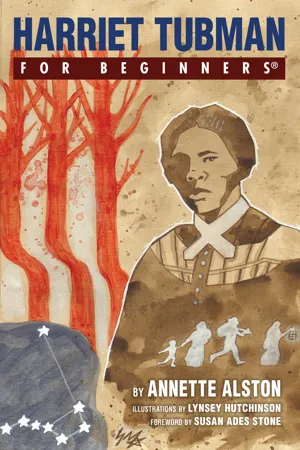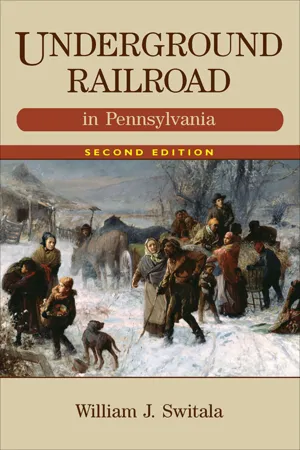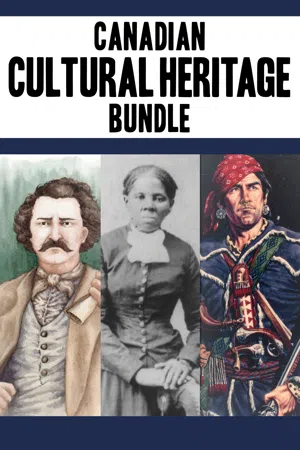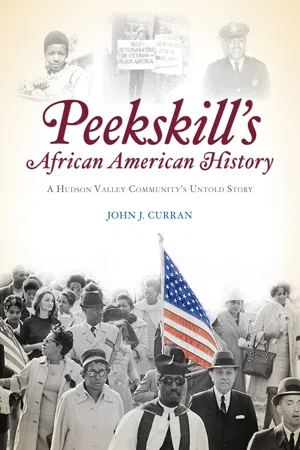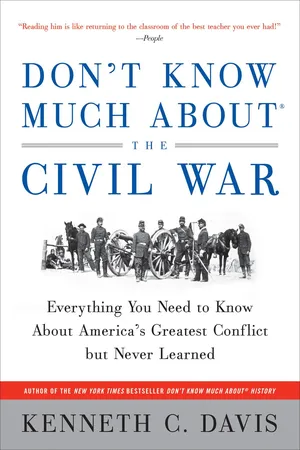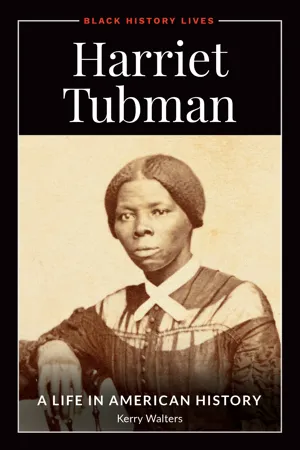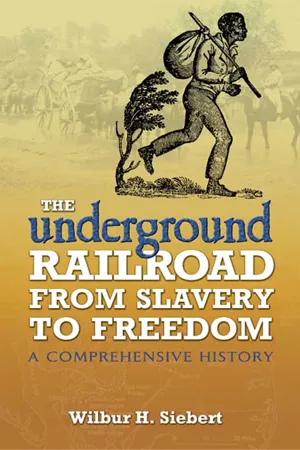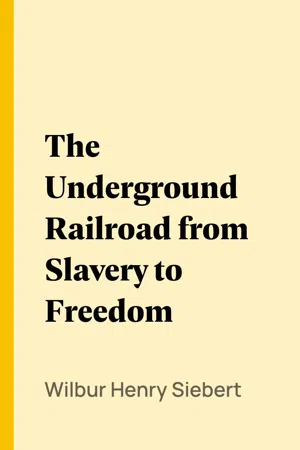History
Underground Railroad
The Underground Railroad was a network of secret routes and safe houses used by enslaved African Americans to escape to free states and Canada in the 19th century. It was not an actual railroad, but a metaphor for the covert system that helped thousands of individuals seek freedom from slavery. The network was operated by abolitionists and sympathetic individuals who risked their lives to assist escaping slaves.
Written by Perlego with AI-assistance
Related key terms
Related key terms
1 of 4
Related key terms
1 of 3
10 Key excerpts on "Underground Railroad"
- eBook - ePub
- Annette Alston, Lynsey Hutchinson(Authors)
- 2017(Publication Date)
- For Beginners(Publisher)
While widely acclaimed for her fearlessness and determination in the face of grave dangers, Harriet Tubman did not act in a void. She operated as part of a network of abolitionists, free blacks, and other supporters who worked for the cause of freedom—by sharing information and hiding, transporting, or feeding runaways on the route north—at all costs and at personal risk. This informal network was called the Underground Railroad.The term “Underground Railroad” first appeared in a Washington newspaper article in 1839, describing a slave's desire to escape on a metaphorical railroad that “went underground all the way to Boston.” Within a few years, the name became synonymous with a clandestine path to freedom on which escaped slaves were called “passengers,” those who guided them were called “conductors,” and the homes in which they were hidden were called “stations.”The network ran north all the way to Canada, but it was not as extensive or well organized in some areas as in others. The likelihood of escape was more remote in the Deep South, though some resourceful runaways found their way to the Caribbean, South America, and free states and territories in the American West, such as California. The heaviest flow of fugitives originated in the three border states of Maryland, Kentucky, and Virginia meandered north across the Mason-Dixon Line.Maryland had the largest free black community in the United States as then constituted. Baltimore alone, the “black capital” of the Upper South, had “25,442 men, women, and children in 1850, compared with fewer than 3,000 slaves.”1 That fact, combined with its proximity to the North and a well-developed transportation system by train or ship, made it a major hub for operators of the Underground Railroad.FUGITIVE SLAVE LAWSThe Fugitive Slave Act of 1793, passed in the early years of the republic, treated runaway slaves as personal property and gave Southern slaveholders the right to recapture them anywhere in the country (including non-slave states). The problem was that many state laws, and the reluctance of many ordinary citizens to assist, made it difficult for slave owners to reclaim their runaways. The Fugitive Slave Act of 1850, passed as part of the Compromise of 1850 between Northern and Southern states, struck down the efforts of free states to protect accused runaways, imposed fines or imprisonment on ordinary citizens for aiding or assisting a fugitive, and mobilized the army, US marshals, and the federal court system to halt the flight of slaves from the South, capture them in the North, and prosecute officials and citizens who did not turn them in. - eBook - ePub
- Thomas Dresser(Author)
- 2017(Publication Date)
- The History Press(Publisher)
34While the danger and bravery fell primarily on black shoulders, it was risky for the white people who harbored the fugitives, as the federal response to fugitives grew more intense in response to the pleas of southern slave owners. “The Underground Railroad represents a moment in our history when black and white Americans worked together in a just cause.”35 With the current popular interest in the Underground Railroad, it is important to recognize that it was a joint effort between black and white. “In the entire history of slavery, the Railroad offers one of the few narratives in which white Americans can plausibly appear as heroes. It is also one of the few slavery narratives that feature black Americans as heroes—which is to say, one of the few that emphasize the courage, intelligence, and humanity of enslaved African-Americans rather than their subjugation and misery.”36Historian Foner goes on, “The story of the Underground Railroad remains one with an extraordinary cast of characters and remarkable tales of heroism, courage, and sheer luck.”37 As the political divide over slavery widened, Foner states that the Underground Railroad, although operating undercover, attained a “quasi-public” status in the years leading up to the Civil War.Abolitionists worked not only to free slaves but also to provide opportunities once the fugitives settled in the North. “Underground Railroad operatives were deeply involved in campaigns for equal citizenship for northern free blacks, including the right to vote, access to public education, and economic opportunity.”38And Canada offered a safety zone for fleeing fugitives. “Canada offered blacks greater safety and more civil and political rights—including serving on juries, testifying in court, and voting—than what existed in most of the United States.”39 Historian Foner continues: “The vast majority of runaway slaves went onward from New York City headed to Canada via that region, where antislavery sentiment had spread rapidly and the Underground Railroad operated with amazing impunity.”40 - eBook - ePub
William Still
The Underground Railroad and the Angel at Philadelphia
- William C. Kashatus(Author)
- 2021(Publication Date)
- University of Notre Dame Press(Publisher)
The enterprise consisted of a loose network of abolitionists who lived in the border and northern states and assisted runaway slaves escaping bondage in the South for freedom in the North. There is evidence that some type of organized assistance existed as early as 1786, when George Washington, in a letter to a friend, referred to a slave “whom a society of [Philadelphia] Quakers attempted to liberate.” 12 Washington may have been referring to the Pennsylvania Abolition Society, but virtually all of their work at that time was limited to the relief of free blacks, not slaves. The following year, Isaac T. Hopper, a Philadelphia Quaker, developed a systematic plan for helping slaves escape bondage in the South. Within the next few years, fugitives were receiving assistance from many towns in Pennsylvania, which apparently served as an example for antislavery activists in other towns just over the free state border. 13 One legend maintains that the term Underground Railroad was coined in 1831, shortly after the new technology of the steam railroad was introduced in the United States. According to the story, a runaway by the name of Tice Davids escaped from a Kentucky plantation and made his way across the Ohio River. Refusing to be deprived of his property, the owner followed in swift pursuit. But when he crossed the Ohio he lost all trace of his slave. Confounded, he supposedly remarked that Davids must have “gone off on an Underground Railroad.” 14 Accordingly, the abolitionists who organized the network adopted the vocabulary of the railroad to hide their illegal activities. For example, agents who gave shelter to runaways referred to themselves as “stationmasters” and their homes as “stations.” Other agents who guided fugitives between stations were “conductors.” Less common but every bit as critical to the success of the enterprise were “stockholders,” who contributed the funds needed to feed, clothe, and transport fugitives - eBook - ePub
Underground Railroad
in Pennsylvania
- William J Switala(Author)
- 2023(Publication Date)
- Rowman & Littlefield Publishers(Publisher)
Operation of the RailroadT he Underground Railroad—the system by which slaves escaped bondage and fled to the North before the Civil War—embodied many types of activities. They ranged from methods of escape and the people who aided the self-emancipators, to the routes they took to gain their freedom. The stories of these flights to freedom involve people who set out on this hazardous journey and the many hardships they experienced on the way to reaching their goal. It is also the story of the heroism on the part of those fleeing and those helping them to escape.Some modern researchers are skeptical of the descriptions of the Underground Railroad, however. Scholar Larry Gara epitomizes this point of view. In his 1967 book, The Liberty Line: The Legend of the Underground Railroad, he states, “Although the Underground Railroad was a reality, much of the material relating to it belongs in the realm of folklore rather than history.”1 He points out a serious flaw in the traditional works on the Underground Railroad that portrays the fugitive slave as a rather passive figure in the attempt to escape and implying that it is only through the heroic efforts of white Underground Railroad agents that the goal of freedom was reached.2 Gara is especially critical of Wilbur Siebert’s comprehensive work published in 1898, The Underground Railroad: From Slavery to Freedom. He asserts that Siebert’s research is too grounded in the sketchy recollections of former agents or their children. Gara goes so far as to say that Siebert embellished the facts based on faulty research methods. Another traditional work on the topic, Robert Smedley’s History of the Underground Railroad in Chester and the Neighboring Counties of Pennsylvania, published in 1883, also garners Gara’s criticism. He feels that Smedley leaves the reader with the impression that it was only through the efforts of white Quakers that slaves gained their freedom.3 - eBook - ePub
Canadian Cultural Heritage Bundle
Louis Riel / Harriet Tubman / Simon Girty
- Sharon Stewart, Edward Butts, Rosemary Sadlier(Authors)
- 2013(Publication Date)
- Dundurn Press(Publisher)
Work might slow down on Sundays as Christian owners and overseers would not work on their Sabbath day. Religion was given to the slaves only to reinforce their inferior position and justify their abuse. If a slave died, he or she could only be buried at night because the master’s needs for the labour of his slaves always came first, well above the emotional trauma felt by the slave community over losing a loved one. The images of freedom and movement in many of the hymns did help to provide images of a life that might be had possibly in the North or after death. Those hymns became codes for people who were willing to follow the call for freedom.The Underground Railroad was born of the desperation and resolve of black people to be free, and the commitment and resources of free blacks and whites to end slavery. The Underground Railroad was the name of a means of escaping slavery through using various trails, safe houses, and vehicles. It was a system of people helping people to be free, but being connected to the Underground Railroad was dangerous. The Underground Railroad “carried” its human cargo from the late 1700s until slavery was abolished in the United States beginning in 1863. It was the busiest from 1850 on because of the passing of the second Fugitive Slave Act , which put all blacks, whether free-born, manumitted (granted their freedom in the Will of their owner), or runaway, at risk of recapture no matter where they were in the United States. By this time, many of these black peoples had been free for several generations and had acquired considerable property. If they resisted being re-enslaved they were beaten or killed. Some black families were even kidnapped in the middle of the night.A “ride” on the Underground Railroad would not be comfortable. Your conductor would lead you north on foot by night through swamps, paths, river shores, and forests. If you were lucky, you would have part of your passage on a real train or a boat paid for or provided by abolitionists — but you might have to wear a disguise since you could end up sitting beside someone who could identify you. You might travel from one station to another in a secret compartment of a wagon or on a makeshift boat. Your food would consist of whatever you had been able to carry and whatever you could find during the six to nine weeks your trip could take. Your sleeping quarters might be a hollow tree, a culvert under a bridge, a cemetery, a root cellar, a barn, a cave, or the open terrain. Until you reached your final destination, you would be in constant fear of being recaptured. - eBook - ePub
Peekskill's African American History
A Hudson Valley Community's Untold Story
- John J. Curran(Author)
- 2008(Publication Date)
- The History Press(Publisher)
Harriet Tubman broke free of her enslavement in the South in 1849. She stated, “I crossed the line of which I was for so long dreaming. I was free, but there was no one to welcome me.” One might escape, but then what? There was no welcome and no help. Only fear, poverty, loneliness and danger offered themselves as companions.Ms. Tubman personally experienced such agonizing freedom. A woman of strong character and organizing abilities, she immediately became an active creator and leader in the secret network that helped many black Americans escape slavery’s confinement, physical misery and personal outrage.People with black, brown and white skin tones, mostly people with religious faith, were able to link together, communicate and physically time arrivals, departures and layovers through several states and into Canada with amazing efficiency.The Underground Railroad was a humane transportation conspiracy. This support system was known as a “Freedom Line,” “Emancipation Car,” “Gospel Train” and by other names. The secret train to freedom was invisible, magical and effective. It offered escape and a better life. Only those who were its passengers and conductors saw this train. It was not supposed to be seen by anyone who was not part of its activities. This train operated out of sight, or “underground.”By breaking laws in several states, especially the harsh national Fugitive Slave Law of 1850 that required people to return slave property to their owners with penalties for those who interfered, those people who helped refugees from slavery risked legal and physical dangers.Ohio was the most active state, with Underground Railroad trails and active participants. The Oberlin-Wellington Rescue was a team of forty black and white men who were jailed for forcefully tracking down slave catchers. The voluntary guides, conductors, operators of safe houses and many others whose names will never be known decided to take extra steps to travel uncertain and unseen roads because they felt and realized this was the right thing to do. - eBook - ePub
Don't Know Much About the Civil War
Everything You Need to Know About America's Greatest Conflict but Never Learned
- Kenneth C. Davis(Author)
- 2009(Publication Date)
- HarperCollins e-books(Publisher)
Both escapes—by the Crafts and Douglass—made international celebrities of these former slaves. The Crafts made their escape relying mostly on their own wits until they reached Philadelphia. There, like Douglass, they received help. The last phase of the Crafts' escape and Douglass's route brought them in touch with the Underground Railroad, a legendary chapter in American history that has been both mythologized and misunderstood.The first myth concerning the Underground Railroad is that it was the creation of benign whites who oversaw its efficient, friendly operation. The second is the number of slaves who actually used it. Called by some the Liberty Line, the Underground Railroad was a loose national network of mostly black abolitionists who illegally helped fugitive slaves reach safety in the free states or Canada. Begun in the 1780s under the auspices of Quakers and other church groups, the network gradually grew into a widespread chain of safe houses along routes to the free states and Canada (although some escapes from the Deep South went through Mexico, where slavery was also illegal). There was never any actual railroad, but the system gradually came to be called the Underground Railroad, and the safe houses became known as stations or depots. Along the route, black fugitives were concealed, provisioned, and guided from one stop to the next, often at great risk to the “conductors” and “station-masters.”Although routes ran all the way north from the Deep South, most of those who escaped successfully were, like Frederick Douglass, from the upper South. Also like Douglass, those most able to escape were generally unattached young men. Some were highly skilled, although few were literate. Flights by families or couples, like the Crafts, were rare. The slaves were often initially contacted by a conductor posing as a peddler or mapmaker.Traveling by night, many of the fugitives relied on rumors of safe houses and little more than the North Star for guidance. Usually they sought isolated stations (farms) or vigilance committees in towns a night's journey apart, where sympathetic free blacks could effectively conceal them. By day, they hid in barns and caves, fed and cared for by the stationmaster. Eventually other conductors met them at such border points between the free and slave states as Cincinnati, Ohio, and Wilmington, Delaware, until they made their way to the Great Lakes ports of Detroit, Sandusky, Erie, and Buffalo—all terminals for the final leg of the journey into Canada and freedom. - eBook - ePub
Harriet Tubman
A Life in American History
- Kerry Walters(Author)
- 2019(Publication Date)
- ABC-CLIO(Publisher)
Chicago Western Citizen carried an illustration of a heavily passengered train steaming into an underground tunnel. Captioned “Liberty Line,” the ad boasted that “the improved and splendid Locomotives” regularly ran clients between “Patriarchal Dominion and Libertyville, Upper Canada. Gentlemen and Ladies, who may wish to improve their health or circumstances, by a northern tour; are respectfully invited to give us their patronage” (Harris 1904, 16).Supporters and critics of the Underground Railroad soon began using rail terminology to refer to it. Escape routes became “lines” or “tracks.” Fugitives were referred to as “passengers” or sometimes as “packages.” Volunteers became “conductors” or “agents,” safe houses became “stations” or “depots,” and the people who owned them “stationmasters.” Citizens who weren’t directly involved as either agents or stationmasters but who contributed supplies and funds were known as “stockholders.”The nomenclature that became associated with the Underground Railroad was deliberately cryptic because all the activities along it were necessarily secretive. It also contributed to the aura of mystery that surrounded the enterprise, and from that mystery arose any number of legends that ballooned the Railroad’s actual accomplishments. It was soon falsely presumed, for example, that it had meticulously charted routes traversing every village, town, and city in the nation and that agents and stationmasters took special oaths, punishable if broken by a sure and horrid death, should they divulge the Railroad’s secrets. In fact, however, there’s no evidence of such secret oaths, and the liberty lines only sketchily penetrated the borders of slave states such as Maryland, Virginia, Delaware, and Kentucky in the Upper South, and were virtually absent in the Deep South. They ran primarily in the free states.What this meant is that slaves fleeing bondage were usually responsible, unless they had an experienced guide like Harriet Tubman, for finding their way to the nearest Underground Railroad station on their own. Some free blacks in the border slave states, especially Maryland and Delaware, were willing to aid runaways as best they could, offering them temporary places to rest and a little food. Word-of-mouth directions on where to find these friendly havens, as well as the safest back roads to take northward, circulated throughout slave communities. For the most part, fugitive slaves, many of whom had never ventured far from their plantations and for whom the “North” was often vaguely imagined as being thousands and thousands of miles distant, had to initiate their own escapes. Masters, in an effort to deter escape attempts, contributed to the confusion by frequently exaggerating the geographical distance to the free states. - eBook - ePub
The Underground Railroad from Slavery to Freedom
A Comprehensive History
- Wilbur H. Siebert(Author)
- 2012(Publication Date)
- Dover Publications(Publisher)
CHAPTER XTHE Underground Railroad IN POLITICS
TO set forth the political aspect of the Underground Railroad is not easy. Yet this side must be understood if the Underground Railroad is to appear in its true character as something more than a mere manifestation of the moral sentiment existing in the North and in some localities of the South. The romantic episodes in the fugitive slave controversy have been frequently described; but it has altogether escaped the eye of the general historian that the underground movement was one that grew from small beginnings into a great system ; that it must be reckoned with as a distinct causal factor in tracing the growth of anti-slavery opinion; that it furnished object lessons in the horrors of slavery without cessation during two generations to communities in many parts of the free states ; that it was largely serviceable in developing, if not in originating, the convictions of such powerful agents in the cause as Harriet Beecher Stowe and John Brown ; that it alone serves to explain the enactment of that most remarkable piece of legislation, the Fugitive Slave Law of 1850 ; and, finally, that it furnished the ground for the charge brought again and again by the South against the North of injury wrought by the failure to execute the law, a charge that must be placed among the chief grievances of the slave states at the beginning of the Civil War.GERRIT SMITH, M.C., the multi-millionnaire, whose mansion in Peterboro, New York, was a station.CHARLES SUMNER, THE CHAMPION OF THE FUGITIVE SLAVE IN THE SENATE OF THE UNITED STATES.JOSHUA R. GIDDINGS, M.C., who kept a room in his house in Jefferson, Ohio, for fugitivesRICHARD H. DANA, JR., - eBook - ePub
The Underground Railroad from Slavery to Freedom
A comprehensive history
- Wilbur Henry Siebert(Author)
- 2015(Publication Date)
- Perlego(Publisher)
(From a photograph in the possession of the Kansas State Historical Society.)CHAPTER XI
EFFECT OF THE Underground Railroad
The effect of Underground Railroad operations in steadily withdrawing from the South some of its property and thus causing constant irritation to slave-owners and slave-traders has already been commented upon. The persons losing slaves of course regarded their losses as a personal and undeserved misfortune. Yet, considering the question broadly from the standpoint of their own interests, the work of the underground system was a relief to the masters and to the South. The possibility of a servile insurrection was a dreadful thing for Southern minds to contemplate; but they could not easily dismiss the terrible scenes enacted in San Domingo during the years 1791 to 1793 and the three famous uprisings of 1800, 1820 and 1831, in South Carolina and Virginia. The Underground Railroad had among its passengers such persons as Josiah Henson, J. W. Loguen, Frederick Douglass, Harriet Tubman, William Wells Brown and Henry Bibb; it therefore furnished the means of escape for persons well qualified for leadership among the slaves, and thereby lessened the danger of an uprising of the blacks against their masters. The negro historian, Williams, has said of the Underground Road that it served as a "safety-valve to the institution of slavery. As soon as leaders arose among the slaves, who refused to endure the yoke, they would go North. Had they remained, there must have been enacted at the South the direful scenes of San Domingo."[965]It is difficult to arrive at any satisfactory idea of the actual loss sustained by slave-owners through underground channels. The charges of bad faith against the free states made in Congress by Southern members were sometimes accompanied by estimates of the amount of human property lost on account of the indisposition of those living north of Mason and Dixon's line to meet the requirements of the fugitive slave legislation. Thus as early as 1822, Moore, of Virginia, speaking in the House in favor of a new fugitive recovery law, said that the district he represented lost four or five thousand dollars worth of runaway slaves annually.[966] In August, 1850, Atchison, of Kentucky, informed the Senate that "depredations to the amount of hundreds of thousands of dollars are committed upon the property of the people of the border slave states of this Union annually."[967] Pratt, of Maryland, said that not less than $80,000 worth of slaves was lost every year by citizens of his state.[968] Mason, of Virginia, declared that the losses of his state were already too heavy to be borne, that they were increasing from year to year, and were then in excess of $100,000 per year.[969] Butler, of South Carolina, reckoned the annual loss of the Southern section at $200,000.[970] Clingman, of North Carolina, said that the thirty thousand fugitives then reported to be living in the North were worth at current prices little less than $15,000,000.[971] Claiborne, the biographer of General John A. Quitman, who was at one time governor of Louisiana, indicated as one of the defects of the second Fugitive Slave Law its failure to make "provision for the restitution to the South of the $30,000,000, of which she had been plundered through the 100,000 slaves abducted from her in the course of the last forty years" (1810-1850);[972] and the same writer stated that slavery was rapidly disappearing from the District of Columbia at the time of the enactment of the new law, the number of slaves "having been reduced since 1840 from 4,694 to 650, by 'Underground Railroads' and felonious abductions."[973]
Index pages curate the most relevant extracts from our library of academic textbooks. They’ve been created using an in-house natural language model (NLM), each adding context and meaning to key research topics.
Explore more topic indexes
Explore more topic indexes
1 of 6
Explore more topic indexes
1 of 4
